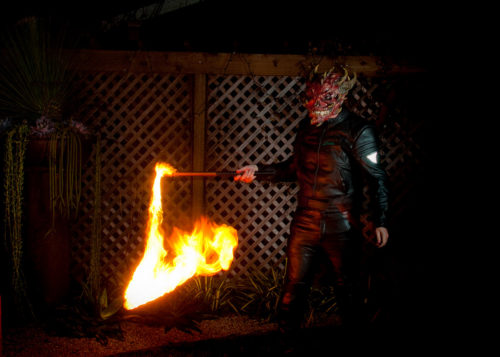
We do a lot of dangerous things here but this one is off the charts. So hurt yourself, and you can’t come running to us. This is all about you and your boundaries.
Let us show you how we made a Fire Wand / Fire Whip. Strictly speaking it’s not a whip because you can’t crack it. You can buy those online but they’re hella expensive. We made one for relatively little cost, and so far it’s only caused minor damage and the loss of hair from one hand.
Watch the video then read on. There’s modifications we made to the instructions after the video was produced that make the whole thing a lot less dangerous.
Two things to note about the video. Firstly, you really should never keep fuel in plastic containers. And secondly, the whip handle we made is a tad too short for some of the more exotic fuel mixtures and so is a little dangerous. Let’s address those items, then get on to talk about fuel.

For the last 4 months we’ve been keeping the fuel in a plastic 5 gallon pail with a screw top. We’ve always known this was wrong but we simply couldn’t find a better solution. About 2 months in to this, the screw top seized. We assume the fuel destabilized the plastic and caused it to warp in some way. We switched brands and the same thing happened again.
We’re in the process of evaluating a steel pail with a crimped lid. We’ll let you know if it works out for us.
In addition, if you visit all the Poi sites they’ll advise that you use a metal pail for your spin bucket. I see no reason for this. It contains almost no fuel, and you get way more size options in plastic.
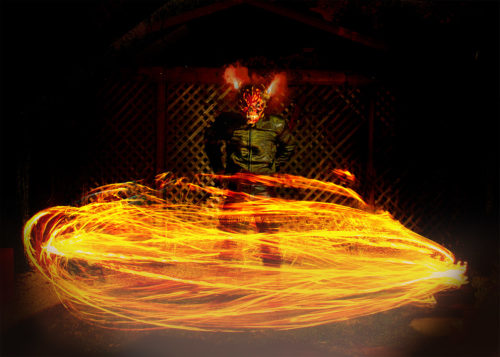
The reason we made the whip handle out of some plumbing parts is that we’re lazy. We didn’t want to have to weld, cut, bend or generally work too hard at getting the bits we wanted. Sadly, it didn’t work out. In fact, if you look at the first few frames of the video you can see the flames nicely toasting horse-head’s hand. And so a new method was needed.
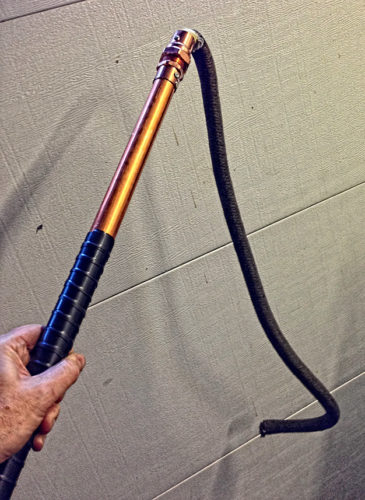
And here it is. Version 2.0. Looks Steam Punk don’t you think?
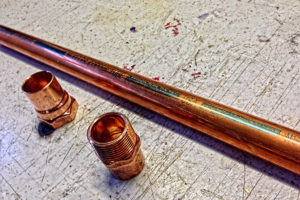 We start with this, pre-cut 2 foot long tube of brass along with male and female joints. In the real world these joints are soldered on to the pipe using a very hot flame. Not having such a thing, we decided to drill and screw ours. It’ll never hold water but it should be good for hurling fire.
We start with this, pre-cut 2 foot long tube of brass along with male and female joints. In the real world these joints are soldered on to the pipe using a very hot flame. Not having such a thing, we decided to drill and screw ours. It’ll never hold water but it should be good for hurling fire.
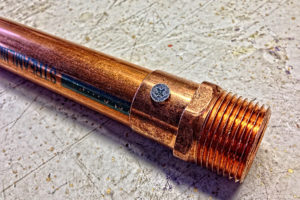 Likewise, the end that fastens to the kevlar wick can be simple screwed.
Likewise, the end that fastens to the kevlar wick can be simple screwed.
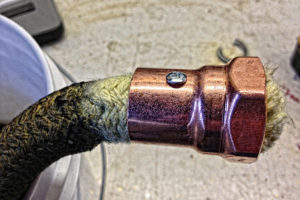 And that’s it. One complete Fire Whip.
And that’s it. One complete Fire Whip.
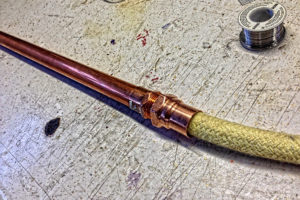 Next, lets talk about fuel. After all, burning stuff is all about the fuel.
Next, lets talk about fuel. After all, burning stuff is all about the fuel.
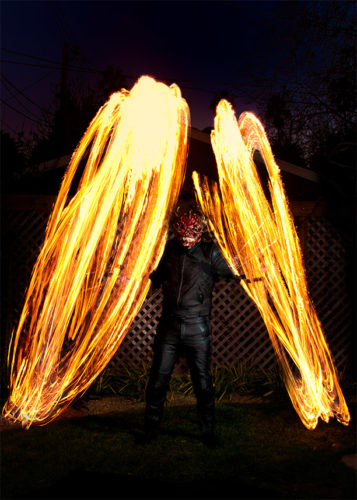
There’s only one rule you should follow when considering the fuel and it’s very simple: don’t use Petrol or gasoline. Really, I’m serious. The very fumes off that stuff will blow your hands off. There’s a story we know about a young horse who once had to go to school with no eyebrows simply because he threw a match at an empty container that used to hold fuel. Seriously, stay away.
So, what should you use? There’s five basic types, and depending on where you live, it’ll have a different name. Type one is kerosene, also known as paraffin, petroleum or in Switzerland “petrol”. I think the Swiss do that just to be odd. Type two is gasoline, also known as petrol or benzine. This is the stuff you should avoid.
Type three is white gas. Also known as Coleman Fuel or white spirits. Type four is alcohol or methylated spirits, ‘meths’. And finally, type five is lamp oil. The most popular type of lamp oil is the brand Citronella that people burn in their gardens on perfect summer evenings to keep the flies away.
Each of these fuels burns at a different temperate, has a different color (naturally, light being a by-product of heat) and some other stuff. Let’s look at all of them.
|
Kerosene |
Gasoline |
White Gas |
Lamp Oil |
|
| Temperature |
Medium |
Insane |
Very Hot |
Warm |
| Flame Size |
Medium |
Insane |
Large |
Small |
| Duration |
Medium |
Short |
Short |
Forever |
| Soot |
Lots |
Little |
Little |
Lots |
| Smoke |
Lots |
Little |
Little |
Some |
| Color |
Orange |
White |
White |
Blue |
| Brightness |
Medium |
Insane |
Very |
Little |
The stuff we use is actually a mixture. We use 50% kerosene and 50% white gas. We’ve tried lots of different mixtures and this gives us the results we want. Lamp oil is generally too messy and white gas on its own is too intense. Cutting it with kerosene seems to work.
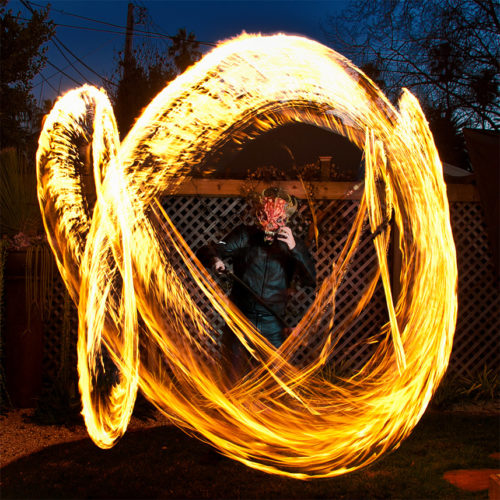
If you don’t like the color of your flame you can alter it by added extra chemicals. We don’t recommend you do this because it will completely ruin your wick. However, each to his own. Here’s what you add to make the various colors:
- Green – Boric Acid
- Red – Lithium Chloride
- Lilac – Potassium Chloride
- Purple – Potassium Nitrate
- Blue – Copper Chloride
And that’s it, be safe. There’s a prize to the first person to spot every double-entendre and willy euphemism in the video.
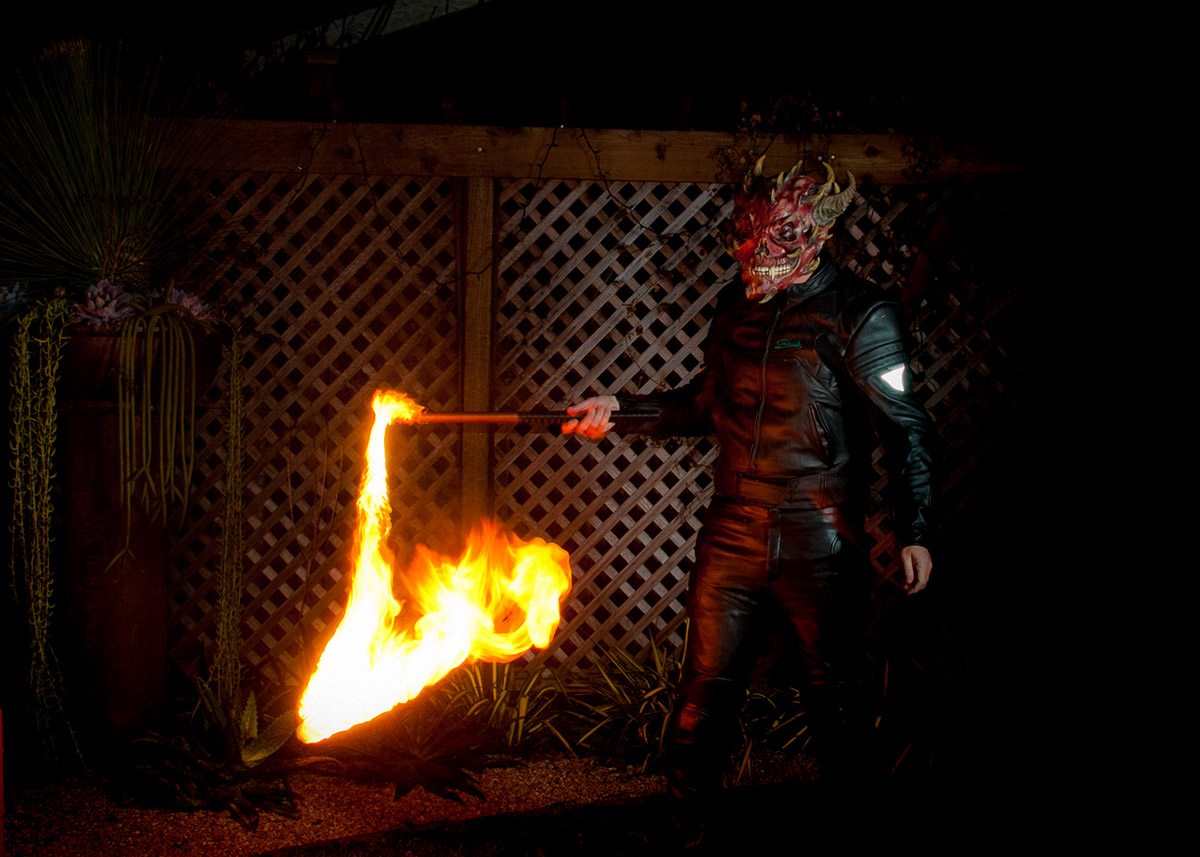
Come on, talk to us!